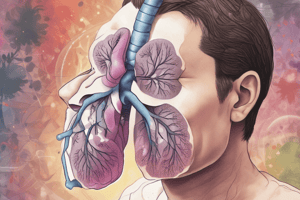Podcast
Questions and Answers
During an acute asthma exacerbation, which chest x-ray finding is LEAST likely to be observed?
During an acute asthma exacerbation, which chest x-ray finding is LEAST likely to be observed?
- Consolidation in the lower lobes (correct)
- Increased A-P diameter
- Translucent (dark) lung fields
- Depressed or flattened diaphragms
A patient with a history of asthma presents to the emergency department with severe wheezing, a respiratory rate of 35 breaths/min, and decreased oxygen saturation. Which initial intervention is MOST appropriate?
A patient with a history of asthma presents to the emergency department with severe wheezing, a respiratory rate of 35 breaths/min, and decreased oxygen saturation. Which initial intervention is MOST appropriate?
- Administer oxygen therapy and a SABA via aerosol (correct)
- Perform a diagnostic bronchoscopy
- Administer intravenous antibiotics
- Initiate chest physiotherapy
Which of the following spirometry results would indicate a significant response to a bronchodilator in a patient with asthma?
Which of the following spirometry results would indicate a significant response to a bronchodilator in a patient with asthma?
- FVC increases by 15% and 300 mL
- PEF decreases by 10% and 100 mL
- FEV1 increases by 8% and 150 mL
- FEV1 increases by 12% and 200 mL (correct)
A patient's asthma action plan includes peak flow monitoring. Which peak flow reading would indicate the patient is in the 'yellow zone' and should use their rescue medication?
A patient's asthma action plan includes peak flow monitoring. Which peak flow reading would indicate the patient is in the 'yellow zone' and should use their rescue medication?
Which of the following is NOT typically considered a long-term control medication for asthma?
Which of the following is NOT typically considered a long-term control medication for asthma?
During physical assessment of a patient experiencing an asthma exacerbation, which finding would suggest the MOST severe respiratory distress?
During physical assessment of a patient experiencing an asthma exacerbation, which finding would suggest the MOST severe respiratory distress?
Which arterial blood gas (ABG) result is MOST indicative of a patient in status asthmaticus?
Which arterial blood gas (ABG) result is MOST indicative of a patient in status asthmaticus?
A patient with persistent, uncontrolled asthma despite adherence to their prescribed medication regimen should be referred to a specialist for what reason?
A patient with persistent, uncontrolled asthma despite adherence to their prescribed medication regimen should be referred to a specialist for what reason?
Flashcards
Asthma Definition
Asthma Definition
A chronic inflammatory disease causing airway obstruction and wheezing.
Common Asthma Triggers
Common Asthma Triggers
Dust, pollen, smoke, animal dander.
Asthma Symptoms
Asthma Symptoms
Shortness of breath, wheezing, chest tightness.
Asthma Chest Percussion
Asthma Chest Percussion
Signup and view all the flashcards
Asthma Breath Sounds
Asthma Breath Sounds
Signup and view all the flashcards
Asthma Spirometry Results
Asthma Spirometry Results
Signup and view all the flashcards
Acute Asthma Treatment
Acute Asthma Treatment
Signup and view all the flashcards
Long-Term Asthma Control
Long-Term Asthma Control
Signup and view all the flashcards
Study Notes
Asthma
- Asthma is a chronic, inflammatory, obstructive, non-contagious airway disease.
- Asthma varies in severity and is characterized by exacerbations of wheezing and coughing.
- Asthma episodes occur when a patient is exposed to a specific trigger, which can include dust, grass, pollen, smoke, and animal dander.
Patient Assessment
- Shortness of breath presents as pursed-lip breathing and chest tightness.
- Chest appearance includes an increased A-P diameter during an episode.
- Respiratory pattern includes accessory muscle usage and retractions, especially in children.
- Diagnostic chest percussion produces a hyperresonant/tympanic note.
- Breath sounds include diffuse wheezing, diminished breath sounds, and prolonged expiration.
- A physical appearance is diaphoresis.
- Vital signs include tachycardia, tachypnea, and pulsus paradoxus during severe episodes.
Diagnostic Testing
- A chest X-ray during an acute episode shows an increased A-P diameter, translucent (dark) lung fields, and depressed or flattened diaphragms.
- Arterial blood gas initially shows acute alveolar hyperventilation with hypoxemia, and may later develop hypercarbia in status asthmaticus.
- Spirometry reveals reduced flowrates, specifically in Peak Flow, FEV1, FEV1/FVC, and FEF25-27%.
- Post-bronchodilator spirometry indicates a significant response if FEV1 increases by at least 12% and 200 mL.
- During a Bronchial Provocation Test, FEV1 decreases significantly when a provocative agent, like inhaled methacholine, is introduced.
Treatment/Management of Acute Episodes
- Administer oxygen therapy.
- Perform aerosol therapy with SABA and anticholinergic agents, while considering continuous aerosol therapy.
- Use corticosteroids, either oral or IV.
- Closely monitor the patient.
- Intubation and mechanical ventilation may be required if ventilatory failure or respiratory arrest occurs.
- Consider adjunct therapies such as heliox therapy, magnesium sulfate, or subcutaneous epinephrine.
Long Term Control of Asthma
- Key to long term control is eliminating, minimizing, or avoiding asthma triggers to prevent acute attacks.
- Control medications include LABA, inhaled corticosteroids, mast cell stabilizers, and leukotriene inhibitors.
- The asthma action plan should be based on peak flow monitoring
Referral Considerations
- Refer patients to a physician specialist when there is difficulty confirming an asthma diagnosis.
- Referrals are also needed for suspected occupational asthma.
- Persistent uncontrolled asthma or frequent exacerbations warrants specialist referral.
- Refer patients for any risk factors for asthma-related death.
- Refer if there is evidence of, or risk for, significant treatment side effects.
References for Evidence-Based Practice:
- National Asthma Education and Prevention Program (NAEPP) is a reference for evidence-based practice.
- Global Initiative for Asthma (GINA) serves as a reference for evidence-based practice.
Studying That Suits You
Use AI to generate personalized quizzes and flashcards to suit your learning preferences.
Description
Explore the characteristics, patient assessment techniques, and diagnostic testing methods associated with asthma. Learn to identify triggers, assess breathing patterns, and interpret chest x-rays. Gain insights into managing this chronic inflammatory airway disease.




